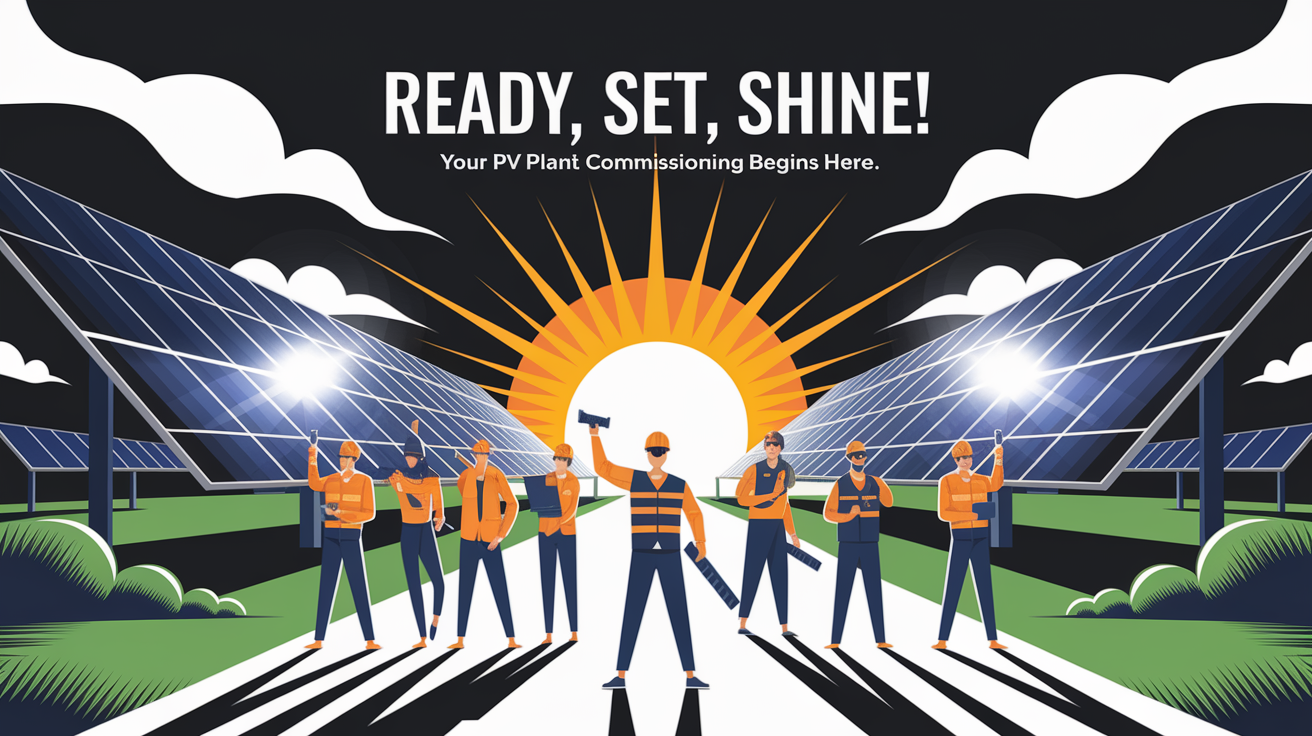Your PV Plant Commissioning Checklist: A Step-by-Step Guide
Ready, Set, Shine! Your PV Plant Commissioning Begins Here
For utility-scale and commercial solar PV plants, commissioning marks the critical transition from construction to operational readiness. This systematic verification process ensures the photovoltaic system is safe, compliant with engineering specifications, and performing at its designed capacity. According to Sunpal Energy, commissioning involves design verification, installation inspection, electrical testing, performance validation, and formal handover — protecting both technical integrity and financial investment.

Whether for a rooftop installation or a sprawling solar farm, the commissioning process serves as a comprehensive quality assurance step. It verifies correct installation of components such as solar inverters, DC combiner boxes, grounding systems, AC disconnect switches, and monitoring systems, and ensures compliance with safety protocols before grid connection. The commissioning engineer plays a central role, backed by calibrated test equipment and precise documentation requirements that meet utility and regulatory compliance standards.
Site and Safety Preparation
Before the first test is run, site and safety preparation is paramount. Pre-commissioning activities include verifying that all permits, interconnection agreements, and approvals are in place. Crews conduct a site walk-through to confirm installation completeness, cable management quality, and adherence to design plans. Safety protocols require functional Lockout-Tagout (LOTO) systems, operational fire extinguishers, and proper use of personal protective equipment (PPE).

In utility-scale environments, weather monitoring stations may be examined for accuracy, while rooftop deployments emphasize secure array mounting and sealed penetrations to prevent water ingress. These steps minimize hazards for commissioning teams and ensure secure access to all photovoltaic installation components.
Equipment Verification
Commissioning engineers systematically inspect and verify all plant equipment against the original engineering drawings and manufacturer specifications. According to Solar Best Practices, this checklist covers inverter configuration, labeling, and serial number logging, the DC combiner box location and wiring, AC disconnect switch functionality, grounding system continuity, and SCADA system integration readiness.

- Check PV strings for correct polarity and string monitoring accuracy.
- Inspect mechanical fastenings, module orientation, and cabling for signs of wear or improper installation.
- Verify Correct earthing connections and grounding electrode installation.
- Ensure monitoring system components are installed and operational before performance testing.
This stage often includes confirming physical conduit sizes, conductor types, and junction box sealing. Accurate equipment verification at this stage underpins reliable electrical testing and long-term operational performance.
Electrical Testing and Performance Checks
Electrical testing is one of the most critical steps in PV plant commissioning. Under IEC 62446 and AS/NZS 5033 standards, crews perform insulation resistance testing, polarity checks, electrical continuity verification, and earthing confirmation before energizing the system. Protective devices are tested to ensure safe disconnection capabilities and fault isolation.

Functional testing procedures include confirming inverter startup sequences, verifying AC and DC voltage values under load, and monitoring system performance via SCADA and local HMI panels. Power quality is assessed for harmonics, voltage stability, and grid synchronization readiness. For off-grid projects, battery banks and charge controller settings are verified against manufacturer recommendations to ensure safe operation and longevity.
- Perform insulation resistance testing for all DC cabling.
- Verify correct polarity and continuity of strings.
- Test inverter response times and MPPT functionality.
- Confirm grounding resistance meets design criteria.
Safety checks include enforcing LOTO procedures and using calibrated measurement tools throughout all electrical testing sequences.
Documentation and Regulatory Compliance
Every commissioning process culminates in rigorous documentation. This includes system performance testing results, electrical safety inspection records, quality assurance reports, inverter configuration settings, and calibration certificates for all test equipment used. Comprehensive documentation ensures the photovoltaic installation meets regulatory compliance and utility requirements for grid connection.
As detailed by Solar Best Practices, commissioning documentation must include as-built drawings, acceptance testing reports, troubleshooting guidelines, and maintenance procedures for ongoing operations. Commercial solar commissioning documentation also covers warranty registrations, spare parts inventories, and emergency response protocols.
Final Flip-Switch: Powering Up with Confidence
With all inspection, verification, and performance testing phases complete, the commissioning engineer proceeds to the final energization. In grid-connected systems, synchronization with the utility network is performed, monitoring the performance ratio to ensure energy yield matches projections from the design stage. This may include real-time data collection from string monitoring equipment and SCADA systems to validate long-term operational readiness.
For clients, the handover includes all operational documentation, training sessions, and guidelines for preventive maintenance. This moment — turning on the system for the first time — signifies not only the completion of the solar energy plant startup procedures but also the start of a decades-long journey of clean energy production.
From site preparation to flipping the final switch, a meticulous PV plant commissioning checklist template transforms solar panel installation into a high-performing, safe, and compliant energy asset. With proper adherence to photovoltaic system commissioning procedures and regulatory standards, stakeholders can move forward knowing their investment is built for consistent yield and minimal downtime.







